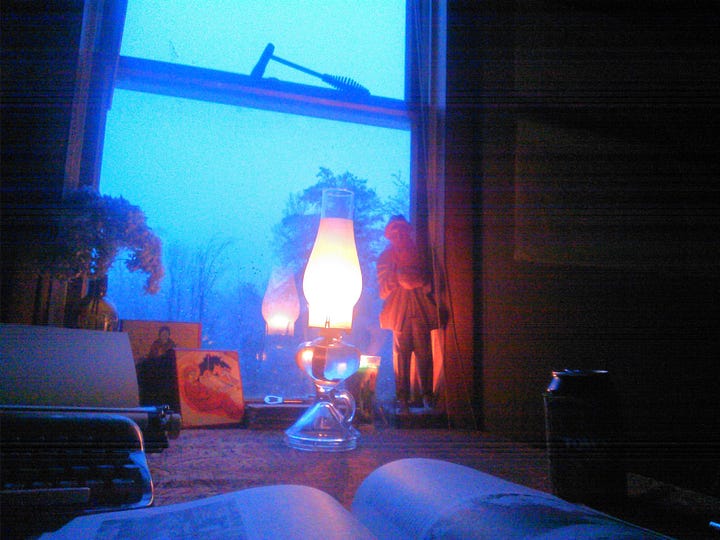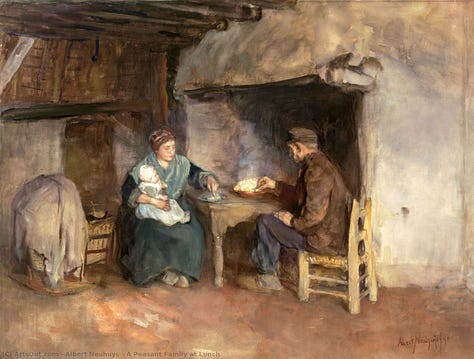In the winter of 2023-24, I attempted to write a book at my cottage near Massena, New York. Each day I reported to my desk, which sits before an east-facing window with a view of a small swamp that I own. We did not see the sun for over six weeks — slate-grey skies presided over the frosted tips of the reeds and the cattails of my little wetland, and I led an entirely reclusive sort of existence, pecking out thousands of words every day. On some days, I managed to write more than ten thousand words, and, bleary-eyed with the peculiar exhaustion that can follow such an effort, I would sit on my porch and sip scotch, wondering whether this book of mine would amount to anything. Even then, I had the sneaking suspicion that it would ultimately require a complete overhaul and re-write.
By the end of it, I became convinced that this book was not worth publishing, as in writing it I sought to achieve too many things at once. I wished to offer the reader not only a “how-to manual” on the vagabond’s life, but to additionally provide extensive reflections on idleness, ingenuity, divinity, and the philosophy of survival, hyperabundance, and home economics. Like a musical work with far too many chords, the result was cacophonous, and I lost any interest in publishing or sharing this work.


Instead, the end result seemed to be, more than anything, a series of unfiltered, unedited notes that could in the course of time result in multiple books. Though I presently lack the time to sharpen each of these ideas into a more concise and readable form, I have decided to share some of last winter’s work here — unedited and un-organized — as some readers of Hickman’s Hinterlands have asked to see it. I do not do this without some trepidation, as the 200-page manuscript is rife with blemishes and flaws, but nevertheless, I offer it here on the thought that it could stimulate some interesting discussion in the comments.
And so without further ado, I present to you some highlights from last winter’s attempt at writing my first book-length work. If there is any interest, I may post more from this manuscript in the future. Thank you for reading Hickman’s Hinterlands.
Introduction to Part I
Twenty pounds of rice is, at the time of this writing, $11.70 at Wal-Mart in Massena, NY. That's less than twelve dollars for 30,000 calories of food. Minimum wage is presently $14.20. This means that within 49 minutes of any form of labor in Upstate New York -- a man can secure for himself enough food to survive for about twenty days. The gravity of this simple fact is easy to miss in the hyperabundant atmosphere of present-day America; after all, who wants to eat nothing but rice for twenty days? Quickly, most souls who've been incorporated into the modern American cornucopia will raise their objections to the fomulation of working for minimum wage for mere rice.
"I can make more than minimum wage," might be the first objection. "I hate rice," might be another, or one might state that "if you lived on only rice you'd become malnourished quickly." Within the context of the modern-day United States, these are all, of course, totally fair objections. There are very few people in this country -- even the very poorest -- who are getting excited about securing twenty days' rice in 49 minutes of minimum-wage labor. But on the historical scale of time, this possibility is an extreme anomaly that would seem practically unthinkable in almost any era but our own, especially for the commoners and peasants of former eras. That the 49 minutes required to secure three weeks of subsistence calories need not involve physical labor of any kind would seem even stranger to our ancient forefathers. Merely sitting at a desk as a hotel night clerk would count for one's monthly rice -- sitting and doing literally nothing at all; even atrophying from physical inactivity.
From the vista of the medieval peasant, the galley slave, and the nomadic forager, even the most trivial victories of the postindustrial era are magnified into enormous triumphs. Barring a spectacular catabolic collapse of techno-industrial civilization, hoeing rough rows of dry earth for a bleak harvest is simply not on the menu of possible existential fates for residents of developed nations. We are very obviously living in the remotest fantasies of men and women who lived with a very real and palpable fear of hunger for millennia -- whether we feel the full weight of this fact or not. This is even, amazingly, true of our very poorest citizens.



The speed with which the wealth of nations has multiplied across the industrial human landscape has been nothing short of breakneck. In only a handful of generations, the threat of starving to death has literally disappeared in the vast majority of the world. In fact, consider that María Brañas Morera is, as of January 2024, the oldest living human being on earth (note: she unfortunately passed away this August — may she rest in peace). Her father, Joseph Branyas Julia, was born in Spain in 1877 -- only two years before Ireland's last major famine in 1879. Indeed, within the span of two human lifetimes, hunger has become an inconvenience in the West -- it is no longer even the remotest decisionmaking factor in how one makes a life for himself.
Perhaps the speed of this change can make it difficult to appreciate what a landmark shift these developments represent in the long story of the human race. The hyperabundance generated by an emergent global system of petroleum-driven technologies in farming, shipping, fertilizer manufacture, and other industries has created a set of circumstances in which the prayerful petition in the Our Father prayer — give us this day our daily bread — is now, in at least some sense, only a vague platitude.



